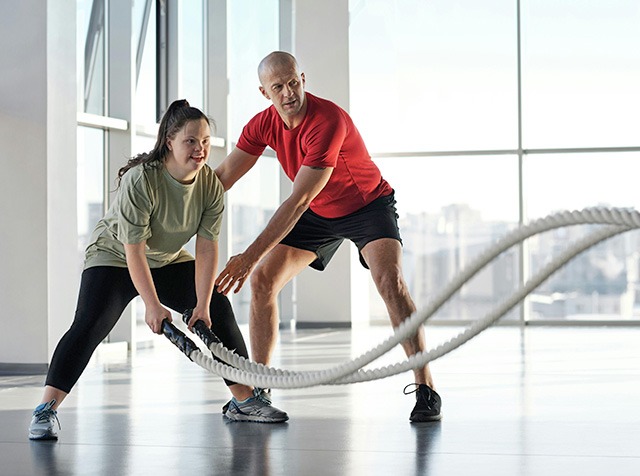Remote trainers are transforming how athletes improve their performance. Leveraging advanced technology, these personal trainers provide customized workout plans and real-time feedback, ensuring every rep counts.
 personal trainer helping a client in the gym
personal trainer helping a client in the gymData-driven insights allow for precise adjustments based on an athlete's progress and unique needs. Athletes now benefit from highly personalized regimes tailored to their goals, fostering peak performance without geographical constraints.
In this article, we will explore how remote training stands at the forefront of sports innovation, setting new standards for efficiency and effectiveness in athletic performance.
Personalized Workout Regimes
Remote trainers use sophisticated algorithms and machine learning to craft personalized workout plans tailored to each athlete's needs. These personal trainers assess an athlete’s current fitness level, goals, and preferences, then create detailed training programs that evolve with their progress.
For instance, platforms like TrainerRoad utilize real-time data from smart devices to adjust intensity levels dynamically. This individualized approach ensures workouts are both effective and safe, reducing the risk of overtraining or injury.
Real-Time Feedback Mechanisms
Beyond just personalized regimes, remote trainers provide invaluable real-time feedback during workouts. Using sensors and wearable tech, these systems monitor an athlete's performance metrics like heart rate, form, and speed. This data gets processed instantaneously to offer on-the-spot advice and adjustments.
Take Strava as an example: it analyzes running or cycling sessions live, offering immediate tips to improve efficiency. These real-time interventions help athletes correct mistakes quickly, maximize their effort in each session, and stay motivated through instant progress tracking.
Data-Driven Adjustments
Another critical advantage of these systems is their ability to make data-driven adjustments. Remote trainers continuously analyze performance metrics, meaning they can identify trends and suggest modifications to an athlete's training plan. If the data indicates that an athlete is plateauing or facing potential overtraining, the virtual personal trainer will recalibrate workout intensity and duration accordingly.
This adaptive approach ensures sustained progress and minimizes injury risks. With precise, evidence-based tweaks based on comprehensive data analysis, athletes maintain optimal performance levels throughout their training cycles.
Enhanced Recovery Strategies
Remote trainers also play a crucial role in optimizing recovery strategies. These systems analyze post-workout data and physiological markers like heart rate variability (HRV) and sleep patterns, providing personalized recovery recommendations.
This can include adjusting rest days, suggesting specific stretching routines, or recommending nutritional interventions to accelerate muscle repair. Proper recovery is essential for preventing injuries and ensuring consistent performance gains.
With tailored advice based on individual metrics, athletes can recover more efficiently, ready to tackle their next training session with renewed energy and reduced risk of burnout.
Optimized Nutritional Guidance
The provision of optimized nutritional guidance is another benefit of remote trainers. By analyzing an athlete's performance data and dietary habits, these systems offer customized nutrition plans to enhance energy levels and recovery.
They consider factors like macronutrient ratios, hydration needs, and timing of meals relative to training sessions. This personalized approach ensures athletes fuel their bodies efficiently for peak performance.
With tailored advice based on specific physiological responses and workout demands, athletes can fine-tune their diet to support their training objectives fully. Remote trainers help create a holistic strategy where exercise and nutrition work in synergy for optimal results.
Enhanced Mental Coaching
Remote trainers offer enhanced mental coaching, a vital aspect of athletic performance. These systems often include modules focused on mental resilience, visualization techniques, and stress management strategies.
Athletes receive tailored advice on maintaining focus during competitions and overcoming psychological barriers. Regular virtual sessions with sports psychologists or guided meditation apps can significantly improve an athlete's mental fortitude. This holistic approach ensures athletes are not just physically prepared but also mentally equipped to handle the pressures of high-stakes environments.
Continuous Motivation and Support
Lastly, remote trainers provide continuous motivation and support, which is crucial for maintaining long-term commitment to training programs. Through apps and platforms, athletes receive regular check-ins, progress updates, and motivational messages.
These virtual interactions help keep athletes engaged by setting incremental goals and celebrating achievements.
Additionally, remote trainers can facilitate community features where athletes share experiences and challenges.This ongoing support creates a sense of accountability, encouraging consistent effort even when motivation wanes.
Closing Thoughts
Remote trainers revolutionize athletic performance by combining advanced technology with personalized coaching. These virtual tools ensure athletes receive tailored workouts, real-time feedback, and continuous support - all critical for peak performance.
Embracing this innovation means athletes aren't limited by geography; they can access world-class training wherever they are. With the sports landscape constantly evolving, those leveraging remote trainers stay ahead of the curve, pushing boundaries and setting new standards in their disciplines.
Related Pages
- Guide to Fitness Trainers
- About a career as a personal trainer
- Working out at home


 Current Events
Current Events